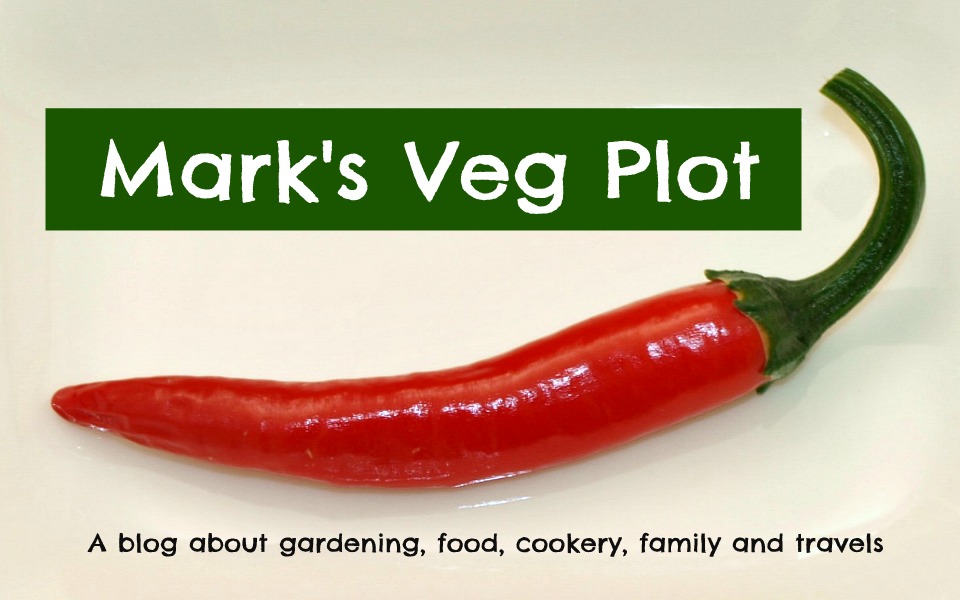This is another very common ailment that affects tomatoes - Blossom End Rot:
Many people think that BER is a disease, but it's actually not. It's probably best described as an "ailment" because it is a physiological problem which happens when fruit cannot properly absorb Calcium from the soil. It is allegedly caused / exacerbated by dry soil. I am very aware of this and I water my tomato plants very assiduously - sometimes twice a day - and the containers in which my plants are growing have water reservoirs in their bases. Still, whatever the reason, the tiny little fruits on my "Primabella" plant have developed it. All the affected fruit is on one truss, so hopefully this is the full extent of it, but there's not much I can do apart from keep on watering thoroughly. BER damage cannot be undone; all one can do is hope to prevent further damage.
Here's the next problem - Leaf-miners attacking the Parsnips:
These things do what their name suggests - they burrow into the leaves and eat the soft interiors, leaving unsightly brown patches. Their routes can be traced via the wiggly silver lines of their burrowing.
Unsightly is probably as bad as this gets. Those Leaf-miners are going to have to eat a lot if they are to do significant damage to my enormous Parsnips! (Well, to be accurate, Parsnip leaves).
Now, I'm sure that most people would not classify the Blackbird as a pest, but many gardeners do. Blackbirds do a lot of damage if they are allowed, and they have a particular liking for soft fruit. I have four large Blueberry bushes, and their fruit is just beginning to show signs of ripening. Funnily enough, it is also starting to disappear. I wonder who / what could be responsible?? The Blueberry bushes are pretty big, and unfortunately I don't have a fruit cage, but I'm determined to preserve at least some of my berries, so I have created a Heath Robinson style cage, knocked-up from bits and pieces - rods, plastic connectors, bamboo canes, a spare piece of netting...
| Blueberry - notice the huge amount of new growth on the right side of this plant. |
The good news for today is that the netting is successfully keeping the Cabbage Whites off my brassicas. The garden is now full of frustrated butterflies flapping round looking for somewhere to lay eggs. The only unprotected brassicas are my spare PSB plants, which are in effect serving as a decoy!

Sometimes I suspect BER happens when a plant simply grows too quickly and can't take up the calcium fast enough. And I think you've read my blog long enough to know what I think of birds, not just blackbirds, plenty of them qualify as pests. And all the rest that you mentioned and more afflict my garden. I wonder sometimes about my sanity, it would be so easy sometime to just let the pests take over.
ReplyDeleteHow fascinating, Michelle in central coastal California, you in (Fleet?) United Kingdom and me in southern inland California, we all have the same problems. I just came inside after the morning round of plant checking. What did I do? Pulled the sick leaves off the tomatoes, cut the damaged fruits off and tossed them, found leaf miners on some peppers, not all, and the new squash Romanesca, but not the old, and the cucumber, and the DBs (darn birds) have eaten all the Asian pesrs. Maybe it's that time of year? the age of the plants? what we grow? I love hearing this from others. Small world, isn't it?
ReplyDeleteMark, I also want to plant Kolarabi and mini brocoli but had a difficult battle with cabbage moth this past May. They ate 70'% of the Kolarabi's leaves within 2 weeks. Can you advice me on the easiest way to set up protective netting? I am not skillful with tools. Sincerely, Kaman
ReplyDeleteThe best way is to buy a kit of lightweight aluminium rods and plastic connectors - I get mine from a firm called Gardening Naturally. Or get some of the things called "Build-a-balls" which can be used with bamboo canes as well as metal rods.
DeleteI just do wonder about BER and watering. Maybe there are other problems causing roots to be less effective. Have you tried a foliar feeding.
ReplyDeleteIt's easy to under water a tomato in a pot. I recently took a full size plant out of it's pot, after watering it properly but to my amazement the bottom quarter was as dry as a bone. I now make sure water seeps out of the bottom of the pots.
ReplyDeleteAndy, this is why the so-called "self-watering" pots that I use are good, because they have a reservoir in the base. It's not very big though, so I still water my toms at least once a day.
DeleteToo bad about the BER, I had a lot of that last year. From what I have read, it has nothing to do with you and everything to do with calcium transport inside the plant, which you really can't control. Plum tomatoes are affected the worst because their growing ends, the flower end, are furthest from the stem supplying nutrients. Cell walls are built with calcium and a lack causes collapse and BER.
ReplyDelete